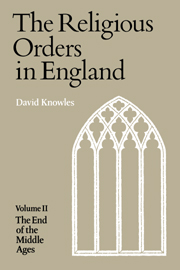Book contents
- Frontmatter
- Contents
- Preface
- List of Abbreviations
- Part One The Historical Framework
- Chap. I The opening of the period
- Chap. II Monks and canons at the university, 130c–1450
- Chap. III Patrons and architects: Ely and Gloucester
- Chap. IV Portraits of monks
- Chap. V Monks and friars in controversy
- Chap. VI Trends in speculation: Ockhamism, justification and grace
- Chap. VII Criticism of the religious in the fourteenth century
- Chap. VIII The spiritual life of the fourteenth century
- Chap. IX Developments within the orders: I
- Chap. X Developments within the orders: II
- Chap. XI The fortunes of the Cluniac houses and the alien priories
- Chap. XII The loosening of discipline
- Chap. XIII King Henry V
- Chap. XIV More portraits of monks
- Chap. XV The second century of visitation, 1350–1450
- Chap. XVI The spiritual life of the fifteenth century
- Part Two The Institutional Background
- Appendix I Chaucer's monk
- Appendix II Henry V and the Westminster recluse
- Appendix III Regulars as bishops
- Bibliography
- Index
Chap. III - Patrons and architects: Ely and Gloucester
Published online by Cambridge University Press: 28 January 2010
- Frontmatter
- Contents
- Preface
- List of Abbreviations
- Part One The Historical Framework
- Chap. I The opening of the period
- Chap. II Monks and canons at the university, 130c–1450
- Chap. III Patrons and architects: Ely and Gloucester
- Chap. IV Portraits of monks
- Chap. V Monks and friars in controversy
- Chap. VI Trends in speculation: Ockhamism, justification and grace
- Chap. VII Criticism of the religious in the fourteenth century
- Chap. VIII The spiritual life of the fourteenth century
- Chap. IX Developments within the orders: I
- Chap. X Developments within the orders: II
- Chap. XI The fortunes of the Cluniac houses and the alien priories
- Chap. XII The loosening of discipline
- Chap. XIII King Henry V
- Chap. XIV More portraits of monks
- Chap. XV The second century of visitation, 1350–1450
- Chap. XVI The spiritual life of the fifteenth century
- Part Two The Institutional Background
- Appendix I Chaucer's monk
- Appendix II Henry V and the Westminster recluse
- Appendix III Regulars as bishops
- Bibliography
- Index
Summary
Monastic architecture as such, the conception, that is, and the detailed designing and building of the fabric of monastery and church, lies outside the scope of these chapters. No department of monastic antiquities has been more fully and, in general, more adequately treated. Moreover, the period in which monastic architecture influenced all ecclesiastical building, and the somewhat later epoch in which the plan of the great black and white monk abbey was finally evolved and standardized, were alike over before 1216. Indeed, by that time, or at least by c. 1260, the vernal burst of bloom was over. The cathedrals and abbeys of England and Wales were in existence with all their main dimensions as we know them now, and save in a very few cases the additions made between 1250 and 1540, great as was their effect upon the external appearance, consisted almost entirely in reclothing the existing fabric, in adding screens, stalls and chapels, and in augmenting the number of towers or repairing those already in existence. Yet though it is not easy to recall a single occasion, after the building of Salisbury, on which a medieval architect had such a clear field and great commission as have since been given to a Wren, a Pugin, a Scott or a Lutyens, yet the sum total of building, even in the monastic churches alone, was very large, and in some cases the work was all but continuous.
- Type
- Chapter
- Information
- Religious Orders Vol 2 , pp. 29 - 38Publisher: Cambridge University PressPrint publication year: 1979



